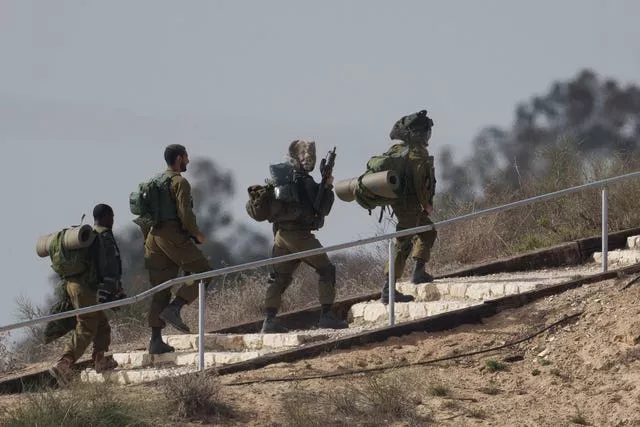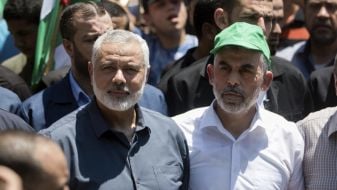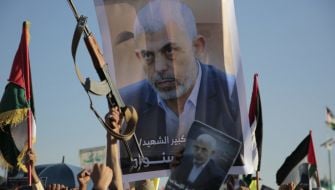Thirty-one premature babies have been safely moved from Gaza’s main hospital to another in the south and will be moved to Egypt, health officials said.
It comes as scores of other critically wounded patients remained stranded there days after Israeli forces entered the compound.
The fate of the newborns at Shifa Hospital captured global attention after photographs showed doctors trying to keep them warm.
A power cut had shut down incubators and other equipment, and food, water and medical supplies ran out as Israeli forces battled Palestinian militants outside the hospital.
World Health Organisation (WHO) chief Tedros Adhanom Ghebreyesus said on social media that the “very sick” babies were evacuated, along with six health workers and 10 staff family members.
He said they were taken to a hospital in the southern Gaza city of Rafah where they are receiving urgent care.
A WHO team that visited the hospital on Saturday said 291 patients were still there, including the babies, trauma patients with severely infected wounds and others with spinal injuries who are unable to move.
About 2,500 displaced people, mobile patients and medical staff left Shifa Hospital on Saturday morning, the WHO said. It said 25 medical staff stayed with the patients.
“Patients and health staff with whom they spoke were terrified for their safety and health, and pleaded for evacuation,” the agency said, describing Shifa as a death zone.
Israel has long alleged that Hamas maintains a sprawling command post inside and under Shifa, part of its wider accusation that the fighters use civilians as cover. It has portrayed the hospital as a key target in its war to end Hamas’s rule in Gaza following the militant group’s wide-ranging attack into southern Israel six weeks ago, which killed more than 1,200 people and triggered the war.
After searching the grounds for days, Israel’s army said on Sunday it had discovered a 55m tunnel about 10m under the hospital’s 20-acre complex, which includes several buildings, garages and a plaza. It said the tunnel included a staircase, blast-proof door and a firing hole that could be used by snipers. The army said it was still uncovering the tunnel’s route.

Hamas and hospital staff deny the allegations and critics have held up the hospital as a symbol of what they say is Israel’s reckless endangerment of civilians. Thousands have been killed in Israeli strikes and there are severe shortages of food, water, medicine and fuel in the besieged territory.
Israeli troops who have been based at the hospital and searching its grounds for days say they have found guns and other weapons and showed reporters the entrance to a tunnel shaft.
The Associated Press (AP) could not independently verify Israel’s findings.
Heavy clashes were reported in the built-up Jabaliya refugee camp in northern Gaza overnight into Sunday. “There was the constant sound of gunfire and tank shelling,” Yassin Sharif, who is sheltering in a UN-run hospital in the camp, said by phone. “It was another night of horror.”
Dozens of people were killed in what witnesses described as an Israeli airstrike on a crowded UN shelter in the Jabaliya camp the day before, according to witnesses. AP photographs from a local hospital showed more than 20 bodies wrapped in bloodstained sheets.
The Israeli military, which has repeatedly called on Palestinians to leave northern Gaza, said only that its troops were active in the area “with the aim of hitting terrorists”.
More than 11,500 Palestinians have been killed, according to Palestinian health authorities. Another 2,700 have been reported missing, believed buried under rubble. The count does not differentiate between civilians and combatants; Israel says it has killed thousands of militants.

Around 1,200 people have been killed on the Israeli side, mainly civilians killed during Hamas’s October 7 attack, in which the group dragged some 240 captives back into Gaza and shattered Israel’s sense of security. The military says 52 Israeli soldiers have been killed.
Hamas has released four hostages, Israel has rescued one, and the bodies of two were found near Shifa in an area where there had been heavy fighting.
Israel, the United States and the Persian Gulf nation of Qatar, which mediates with Hamas, have been negotiating over a hostage release for weeks. On Saturday, a senior White House official suggested it would need to be completed before the entry of large amounts of desperately needed aid.
“A release of a large number of hostages would result in a significant pause in fighting … and a massive surge of humanitarian relief,” Brett McGurk, the White House’s National Security Council co-ordinator for the Middle East, said at a conference in Bahrain.
Qatar’s prime minister, Sheikh Mohammed bin Abdulrahman Al Thani, said on Sunday he is “confident” a deal will soon be reached, telling reporters “the sticking points, honestly, at this stage are more practical, logistical”.
More than two-thirds of Gaza’s population of 2.3 million have fled their homes. The UN agency for Palestinian refugees, known as UNRWA, is struggling to provide basic services to hundreds of thousands of people sheltering in and around schools and other facilities. Their misery has worsened in recent days with the arrival of winter, as cold winds and driving rain buffet tent camps.

Over the weekend, Israel allowed UNRWA to import enough fuel to continue humanitarian operations for another couple of days and to keep internet and telephone systems running.
Israel cut off all fuel imports at the start of the war, causing Gaza’s sole power station and most water treatment centres to shut down, leaving most residents without electricity or running water.
Israeli defence minister Yoav Gallant said on Saturday that Israel’s forces were expanding operations in Gaza City.
“With every passing day, there are fewer places where Hamas terrorists can operate,” he said, adding that the militants would learn that in southern Gaza “in the coming days”.
His comments were the clearest indication yet that the military plans to expand its offensive to southern Gaza, where Israel has told Palestinian civilians to seek refuge. Israel has repeatedly struck what it says are militant targets across the south, often killing civilians.
The evacuation zone is already crammed with displaced civilians and it was not clear where they would go if the offensive moved closer. Egypt has refused to accept any influx of Palestinian refugees, in part because of fears that Israel would not allow them to return.







